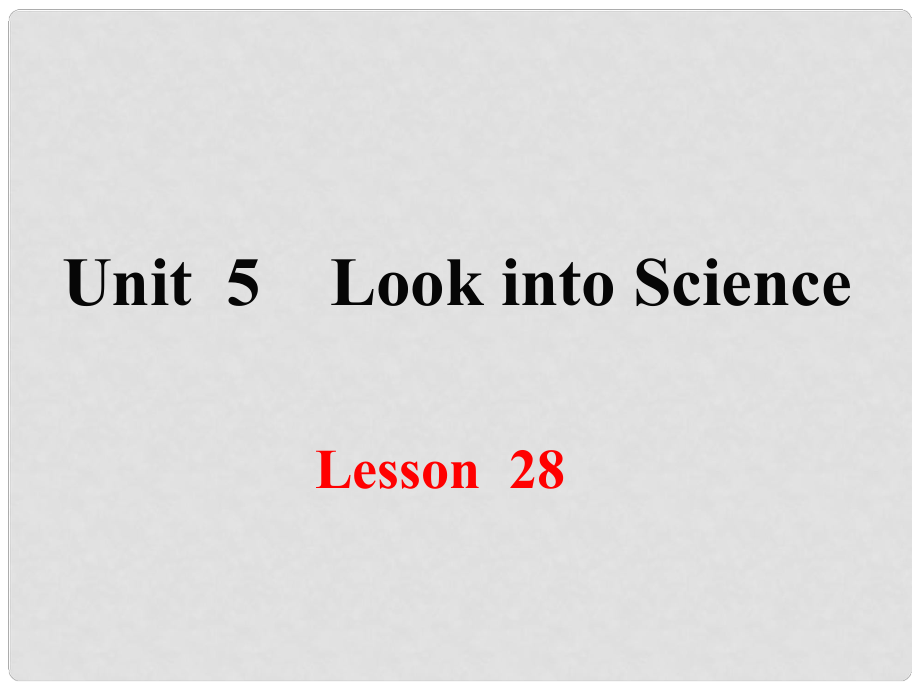《九年級英語上冊 Unit 5 Look into Science Lesson 28 The Study of Living Things課件 (新版)冀教版》由會員分享��,可在線閱讀�����,更多相關(guān)《九年級英語上冊 Unit 5 Look into Science Lesson 28 The Study of Living Things課件 (新版)冀教版(28頁珍藏版)》請?jiān)谘b配圖網(wǎng)上搜索�。
1、Lesson 28Unit 5 Look into Science5學(xué)習(xí)目標(biāo)學(xué)習(xí)目標(biāo)objectivesobjectivesTo learn some new words:biology���,fantastic, butterflyTo understand the passage.To learn Attributive clause.Lead inLead in1.Would you like to be a biologist when you grow up? Why or why not?2.What mysteries of nature do you know about?Think
2���、 about it生物生物蝴蝶蝴蝶遷徙遷徙; 移居移居奇異的奇異的完全地完全地孫子孫子(女女);外孫;外孫(女女)雌性雌性馬利筋(一種植物)馬利筋(一種植物)化學(xué)物質(zhì)化學(xué)物質(zhì)令人費(fèi)解的令人費(fèi)解的biology n. butterfly n.migrate v.fantastic pletely adv.grandchild n.female n. milkweed n.chemical n.puzzling adj.WordsPre-readingPre-reading1.引起某人的注意引起某人的注意2.回到��、返回回到�、返回3.多達(dá)多達(dá)4.下蛋下蛋5.在大學(xué)里在大學(xué)里6.小片的森林小片的森林7
3、.動身去某地動身去某地 draw ones attention Useful expressions:return toas many aslay eggsat a universitysmall piece of forestleave for While-readingWhile-reading1. In the United States and Mexico, farmers use chemicals that kill milkweed. 2. Do the females lay eggs on only one plant?_.3. What does Dr. Chip Tay
4����、lor study? _.4. Here, as many as _ butterflies spend the winter.5.In Mexico, the butterflies always return to the same small piece of forest, which is only 20 kilometers wide ._Read the lesson and finish the exercise.FYes, they doHe studies one kind of North American butterfly230 million在墨西哥,這種蝴蝶總是回
5��、到僅有在墨西哥���,這種蝴蝶總是回到僅有20千米寬的同一小片森林���。千米寬的同一小片森林。T1. 有關(guān)有關(guān)attention的短語的短語2. asas 的用法的用法3. lie 與與 lay的用法的用法4.fantastic5.chemical6.have been drawingLanguage PointsATTENTION1. draw ones attention to sth. (使某人注意某事使某人注意某事).2. catch ones attention (引起某人注意引起某人注意)3. pay attention to sth. (注意���、留心注意���、留心) 4. give ones a
6、ttention to sth. (關(guān)心關(guān)心)ASAS 1. He is _ his father.(像像一樣高一樣高) 2. I do my homework _ my sister does.(像像一樣認(rèn)真一樣認(rèn)真) 3. They see _ one hundred students in front of the library. (像像一樣多一樣多)as tall asas carefully asas many asLIE 與與 LAYThe hens _ (lay) eggs every day.Have you ever _ (lie) to your parents?layl
7���、iedlay (下蛋下蛋) - laid - laid - layinglie (說謊說謊) - lied - lied - lyinglie (平躺平躺) - lay - lain - lying作形容詞,意為作形容詞,意為“奇異的��、極好的��、了不起奇異的��、極好的����、了不起的的”,在句中作定語或表語�。如:,在句中作定語或表語�。如:4. fantasticI think this is a fantastic invention. 我想這是一個(gè)了不起的發(fā)明。我想這是一個(gè)了不起的發(fā)明���。作可數(shù)名詞���,意為作可數(shù)名詞,意為“化學(xué)物質(zhì)��、化學(xué)制品化學(xué)物質(zhì)��、化學(xué)制品”��,復(fù),復(fù)數(shù)形式是數(shù)形式是chemicals���。
8��、如:��。如:There are no chemicals in this kind of food. 這種食品中沒有化學(xué)物質(zhì)��。這種食品中沒有化學(xué)物質(zhì)�����。5. chemical作形容詞��,意為作形容詞�,意為“化學(xué)的�、化學(xué)作用的化學(xué)的、化學(xué)作用的”���,在句中�����,在句中作表語或定語���。如:作表語或定語���。如:We can find chemical additives in many foods. 我們在很多食品中發(fā)現(xiàn)了化學(xué)添加劑����。我們在很多食品中發(fā)現(xiàn)了化學(xué)添加劑。句中的句中的have been drawing 是現(xiàn)在完成進(jìn)行時(shí)��,它是現(xiàn)在完成進(jìn)行時(shí)�����,它由由“助動詞助動詞 have (has) + been + 現(xiàn)
9����、在分詞現(xiàn)在分詞”構(gòu)成,構(gòu)成���,當(dāng)主語是第三人稱單數(shù)時(shí)用助動詞當(dāng)主語是第三人稱單數(shù)時(shí)用助動詞has���,其他情況,其他情況用助動詞用助動詞have�。6. Fantastic facts about the butterfly have been drawing Dr. Taylors attention. 它往往與表示一段時(shí)間的時(shí)間狀語連用�,如:它往往與表示一段時(shí)間的時(shí)間狀語連用���,如:all the time, this month, all day, these few days, for a year, since a week ago等���。等。She has been playing basket
10��、ball after school this week. 這個(gè)星期她放學(xué)后一直打籃球���。這個(gè)星期她放學(xué)后一直打籃球��。Tony has been drawing in his bedroom all the afternoon. 托尼在臥室畫了一下午�����。托尼在臥室畫了一下午����。WHAT DO YOU THINK IS THE MOST FASCINATING THING IN NATURE?Post-readingPost-readingDiscussion Are you familiar with these sentences? They are from the books we have l
11����、earned. 1. In Mexico, the butterflies always return to the same small piece of forest, which is only 20 kilometres wide.2. The butterflies that return to the south are the great-great grandchildren of the butterflies that left for the north.3. But in Mexico, people cut down the trees that the butter
12、flies need to rest on because they want more land for farming.4. In the United States and Canada, farmers use chemicals that kill milkweed.Attributive Clause定語從句定語從句 定語從句定語從句是指在句中作定語的是指在句中作定語的_��。先行詞先行詞是被定是被定語從句所修飾的詞語從句所修飾的詞 (通常是名詞或代詞)。(通常是名詞或代詞)���。關(guān)系詞關(guān)系詞����,也叫作引導(dǎo)詞�����,是在從句中替代先行詞����,在定語從句也叫作引導(dǎo)詞����,是在從句中替代先行詞,在定語從句中充
13����、當(dāng)一定的成分,通常是中充當(dāng)一定的成分����,通常是_或或_����,作��,作_時(shí)?��?梢允÷?����。時(shí)?���?梢允÷?�。先行詞為人時(shí)先行詞為人時(shí)����,引導(dǎo)詞常用,引導(dǎo)詞常用_或或_���;先行詞為物時(shí)先行詞為物時(shí)����,引導(dǎo)詞常用,引導(dǎo)詞常用_或或_�����。從句從句主語主語賓語賓語賓語賓語whothatthatwhich定語從句定語從句Attributive ClausesThe boy who is wearing a black coat bought an iPod yesterday.The experiments that we did yesterday were fantastic. 主語主語定語從句定語從句定語從句定語從句主語主
14�、語修飾修飾the boy修飾修飾 experiments關(guān)系詞的用法關(guān)系詞的用法先行詞先行詞在從句中作在從句中作主語主語在從句中作賓在從句中作賓語語在從句中在從句中作定語作定語指代人指代人who/thatwhom/who/thatwhose指代物指代物which/that which/thatwhose/ of which特殊情況下,由特殊情況下�,由that引導(dǎo)的定語從句:引導(dǎo)的定語從句:1.先行詞為先行詞為all, everything, nothing, something, anything, little, much 等不定代詞時(shí)。等不定代詞時(shí)����。2. 先行詞被先行詞被all, litt
15�����、le, much, every, no 等修飾時(shí)���。等修飾時(shí)��。3. 先行詞被序數(shù)詞或最高級修飾時(shí)��。先行詞被序數(shù)詞或最高級修飾時(shí)����。4. 先行詞被先行詞被the only, the very, the same, the last 修飾時(shí)。修飾時(shí)���。5. 先行詞為人和物的組合���。先行詞為人和物的組合。6. 主句是主句是who/which開頭的特殊疑問句���。開頭的特殊疑問句�����。請給下列的定語從句補(bǔ)充引導(dǎo)詞���。請給下列的定語從句補(bǔ)充引導(dǎo)詞。1. Who is the girl _ talked to you yesterday.2. Look at the photos _ I took on my trip.
16����、3. It successfully shows the rich culture_ makes Beijing so famous.4. The photo_ we liked best was taken by Zhao Min.5. His father is the person_ will be most unhappy.6. Tom is the boy _ we saw in the shop.thatthat/whichthat/whichthat/whothat/whichthat/who7. I am sure she has something _ you can bor
17、row.8. Ive read all the books _ are not mine.9. This is the first book_ he has read.10. This is the very book _ belongs to him.11. They talked for an hour of things and persons _they remembered in the school.thatthatthatthatthatFinish the exercise on P73, 2PracticePractice1.To grasp the contents of this lesson.2.Preview Lesson 29.HomeworkHomework
 九年級英語上冊 Unit 5 Look into Science Lesson 28 The Study of Living Things課件 (新版)冀教版
九年級英語上冊 Unit 5 Look into Science Lesson 28 The Study of Living Things課件 (新版)冀教版

